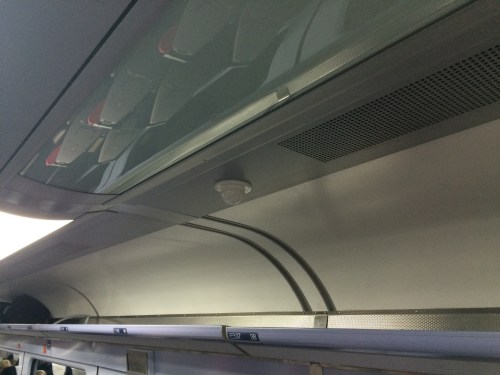
As I write this, this morning, I am using the free wifi courtesy of First Great Western on their High Speed Trains.

You have been able to use wifi on their Cotswold line Adelante trains for a while now, but FGW announced last year they were finally rolling out wifi across their fleet of High Speed Trains on the Great Western mainline. The carriages are been revamped and upgraded and when they are they are having wifi fitted. You can tell if your carriage has been upgraded as they have white domes fitted into the roof.

The speed, as you might expect travelling at 125mph is inconsistent, but having done a speed test I was hanging to get between 5-9 Mbps which is more than reasonable. I was also able to stream video using YouTube and iPlayer. CrossCountry for example block streaming video services on their “you have to pay for it” wifi. Upload speeds were less than 1Mbps, so you may not want to spend your train journey uploading photographs and video.

The train this morning is quite empty, it will be interesting to see how the experience changes as the train fills up as we head to London. I suspect I might be the only person using it at this time, what would happen if we had 84 people in the carriage all trying to watch BBC iPlayer.
As I travelled down the line, you noticed variation in the speed and experience. As I would have expected, the connection was quite flay as we went through the Box Tunnel between Bath and Chippenham.
Over the last few years I have written quite a bit about travelling and connectivity, both in terms of wifi on trains, but also using 3G (and now 4G).
Back in 2007 I wrote an article, This is the age of the train… talking about the refurbishment by FGW, then I said
Do you think I should point out to First Great Western that some train operators provide free wireless on their trains, or do you think that would be pushing it?”
After seven years, it looks like FGW finally listened…
Again in 2010 I wrote another article about train travel and communication
As I travel I like to try and get some work done in the time I have available. One key aspect of my job is communication and for that I need a decent internet connection. First Great Western, unlike some other train operating companies does not provide wifi on their services.
I went onto say
One thing I have noticed though is that though my 3G connection from Bristol to London is pretty good, travelling on the Voyager trains from Bristol to Birmingham, the signal is really poor. I initially thought this was just down to the route, but I have heard that the main issue is the construction of the train and the metallised windows. This basically blocks the 3G signal!
At this time, CrossCountry did not provide wifi, and I discussed this a few months later after the previous post.
I did wonder why CrossCountry Trains didn’t put in wifi as you find on the East Coast Main Line services and Virgin Trains Pendolino. Well it appears that providing wifi was part of their Franchise agreement with the Department of Transport. CrossCountry Trains was suppose to have wifi in place by November 11th 2009. They failed to meet this deadline and the revised deadline of the end of January 2009.
Eventually CrossCountry did put wifi into their trains, which I discovered in 2012 when I travelled with them to Birmingham,
I realised it must have been some time since I last travelled with Cross Country as on my most recent trip with them I was astonished and surprised to find that there was wifi…
A year later I did moan a little about the flakiness of their wifi and why I wasn’t going to renew my subscription.
My main reason was that the last couple of hours was rather flaky and I often had dropped connections. With that kind of connectivity then I might as well rely on 3G and not pay any extra money.
I am still a little astonished it has taken First Great Western until 2014 (and it won’t be complete until 2015), over eight years, to put wifi into their trains, they know that their customers wanted it as did the regulator. We have had wifi in planes for a while, and they travel a little faster and higher than trains. Will the travelling public use the wifi, what with 4G and 3G so much more commonplace than back in 2007?
I should also say that I am still impressed that I can connect to the internet whilst travelling at over a hundred miles per hour.
















